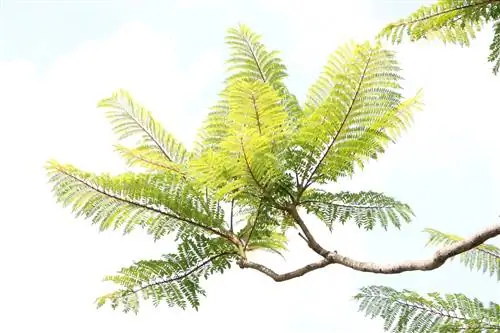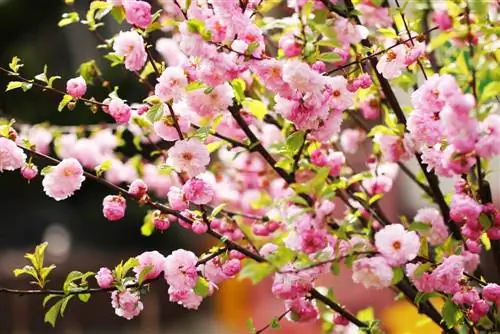- Author admin [email protected].
- Public 2023-12-17 03:39.
- Last modified 2025-01-24 12:45.
The rosewood tree or jacaranda is a beautifully flowering tree that is perceived as very impressive with its size and blue flowers. For this reason it is also very popular as an ornamental plant in private areas. It belongs to the trumpet tree genus and can reach incredible heights.
You will have fun with this tree. Ease of care is a prerequisite for this tree and it is a feast for the eyes for decorative purposes. The flowers are fascinating with their blue tone and it brings a Mediterranean touch to every home.
Peculiarities of the jacaranda tree
When you admire this delicate plant in its pot, you usually cannot imagine that this tree can reach a height of 15-20 meters and become a source of wood. The tree, which belongs to the genus Bignonia, grows very quickly in the right environment, for example in the room, and for this reason can make a sturdy impression. Then it's easiest to cut it all the way back so that it can branch out and become nice and full. There are approximately 50 different jacaranda tree species native to South America. There these trees are also officially called the jacaranda tree. However, only the Jacaranda mimosifolia is kept as an indoor and container plant. Only in rare cases do you come across the Jacaranda ovalifolia, which has egg-shaped leaves.
Best Location for Rosewood Trees
So that this rosewood tree can grow and thrive well, it needs a bright place if possible. However, it does not tolerate the bright sun that shines through the south window very well and therefore windows that face east or west are more suitable. The rosewood tree particularly likes moist air. For this reason, it should be sprayed more frequently on hot days in summer and especially during the heating season in winter. In summer, the plant is very happy with the temperatures and can also be kept outside in the garden from May to September. In winter, a cool place with a temperature of around 15 °C is optimal and ensures that the jacaranda tree feels comfortable. The rosewood tree can also tolerate a temperature of -7 °C for a short time, although it is not winter-proof.
Tip:
If you're on vacation in South America or the Canary Islands, you should pay attention to the rosewood trees on the side of the road and take a look at the seed pods underneath. It is enough to pick up a few of these seed pods, package them well and put them in your luggage. As soon as you get back home, you have to plant the seed pods accordingly. With these you can start your own breeding.
Care: soil, watering, temperature
- When watering, it's better to be careful: not too much water in summer and even less in winter.
- The best method is to feel the soil with your finger to see whether the soil has already dried out.
- Using softened and lukewarm water is doing the rosewood tree a big favor.
- You should fertilize the jacaranda tree in spring and every 14 days in summer.
And if the good piece is to be repotted, then caution is also advised: normal potting soil should be avoided and lime-free soil should be preferred, such as azalea soil or, even better, peat growing substrate (TKS2). Older plants are quite happy if they get a new and larger pot every few years in the spring. The best soil to give the jacaranda tree is compost-based soil.
Raising Jacaranda Tree
The rosewood tree is very easy to grow from seeds and is best done in January and February. Before placing them in the ground, you should soak the seeds in water for a day. If the seeds are not too old, they usually germinate very readily and grow very quickly. It takes approximately 8-14 days for the seeds to sprout. Then you can see the little plants. Ideally, they should be pruned very early so that they branch nicely and become full. If this is not done, they will grow too quickly and then no longer look as attractive or decorative.
Propagate and cut the rosewood tree
- Jacaranda can easily be propagated by seeds.
- Many specialist shops stock seeds of the well-known Jacaranda mimosifolia as standard.
- The seeds must be soaked in water for 24 hours before they can be placed in potting soil.
- The right time for this is after about 2 weeks, when the first germs appear.
- Growing seedlings can be easily carried out even by beginner gardeners.
The jacaranda tree grows very quickly. For this reason, it will always be necessary to radically cut back the tree's shoots. However, the rosewood tree doesn't take offense to this. New shoots form at the interfaces, which ensure that the jacaranda grows wider and has a full growth.
Potential diseases and pests
If a rosewood tree has become bare from below, this may be due to the wrong location or incorrect care. This is the time at which the shoot tips must be cut off so that the tree can grow again from below. If fine spider webs appear in the leaf axils and on the tips of the shoots, then this is a clear sign of spider mite infestation. In this case, the only solution is to either shower the entire plant intensively and thoroughly or, if the infestation has become too severe, to spray extensively with the appropriate spray products.
Botanical description of the jacaranda tree
The German name for this tree is the rosewood tree. It belongs to the trumpet tree family (Bignoniaceae). They belong to the Jacaranda genus and come from South America. The height of these trees can be up to 20 meters and they bear capsule fruits. In terms of sex, they are hermaphrodite and in terms of habitat, monoecious. The rosewood tree can be pollinated through cross-pollination and animal pollination. The leaf arrangement of this plant is opposite and the leaf structure is compound. The leaf shape is clearly pinnate. Another feature are the smooth-edged leaflets.
What you need to know about the rosewood tree
On the whole, this tree is very easy to care for and quite frugal. Its splendor fascinates every observer and for this reason this tree is a pleasure to have around. Breeding is also very problem-free and successful in most cases. It is of course an experience when you have grown this tree yourself and it then decorates the room with its impressiveness. The rosewood tree gets along very well with other plants. Since the tree is mainly kept in pots here, it hardly comes into contact with other plants.
- The species Jacaranda mimosifolia in particular has found a permanent home in Europe.
- If you want to place the rosewood tree in the living room, you should ensure a very bright place.
- However, the jacaranda tree does not tolerate direct sunlight.
- The jacaranda tree should definitely be planted in a pot.
- As this tropical plant cannot withstand temperatures below 10°C, it is not possible to overwinter the tree outdoors.
- As soon as the temperatures are consistently higher than 10°C at night, the rosewood tree can be placed outside.
- This tree feels very comfortable in the garden or on the balcony from the beginning of June to around the end of August.
Care tips
Although the jacaranda comes from subtropical countries, caution is required when supplying water. High humidity is more important than excessive watering, especially in summer. This plant also takes offense at water that is too cold: the water for watering and spraying should always be lukewarm. Watering should occur when the soil begins to dry out. Excessive drying out must be avoided in any case.
Fertilization should be done approximately every 14 days. If you want to plant the jacaranda tree in a pot, you should use special soil. Commercial potting soil does not contain the necessary nutrients for this demanding tree. It is important that the soil contains as little lime as possible and is mixed with compost if possible. When repotting, which must initially be carried out annually, or approximately every 2 years for older trees, care should be taken to ensure that the soil is completely replaced and that the new pot offers sufficient space for the roots.






